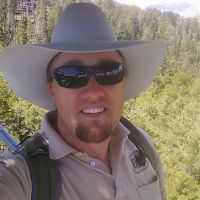Swetnam et al., 2014
Estimating individual tree mid- and understory rank-size distributions from airborne laser scanning in semi-arid forests
Swetnam T.L., Falk D.A., Lynch A.M., and Yool S.R. (2014)
Forest Ecology and Management 330: 271-282
-
Catalina-Jemez, INVESTIGATOR
Abstract
Limitations inherent to airborne laser scanning (ALS) technology and the complex sorting and packing relationships of forests complicate accurate remote sensing of mid- and understory trees, especially in denser forest stands. Self-similarities in rank-sized individual tree distributions (ITD), e.g. bole diameter or height, are a well-understood property of natural, non-plantation, forests undergoing density dependent self-thinning and thus offer an approach to solving this problem. Alternately, semi-arid conifer forests of the southwestern USA that experience episodic wildfires and herbivory tend to exist as open stands compared to forests where disturbances are less common. We found the ITD for semi-arid forest plots with ALS-estimated canopy cover < 50% had a low rate of omission error for mid- and understory ALS trees making distribution fitting of the mid- and understory ITD unnecessary. In dense semi-arid forest plots (>50% canopy cover) the ITD correlated significantly with a tapered Pareto distribution, a power law probability distribution that is not heavy right-tailed. Two-sample Kolmogorov–Smirnov tests confirmed that observed vs. ALS-estimated overstory ITD parameters were not significantly different regardless of canopy cover. Therefore an overstory ITD derived from ALS is sufficient for fitting a continuous distribution function to estimate the ITD of the forest understory when the scale parameter is established a priori. Foresters and ecologists interested in measuring and modeling stand dynamics from ALS can use this approach to correct for stand density effects when developing ALS-derived single-tree inventories. Canopy cover can be used as a proxy for stand density when developing a combined ITD with area-based approaches for estimating understory in semi-arid forests.
Citation
Swetnam T.L., Falk D.A., Lynch A.M., and Yool S.R. (2014): Estimating individual tree mid- and understory rank-size distributions from airborne laser scanning in semi-arid forests. Forest Ecology and Management 330: 271-282. DOI: 10.1016/j.foreco.2014.07.011
 This Paper/Book acknowledges NSF CZO grant support.
This Paper/Book acknowledges NSF CZO grant support.
Explore Further

